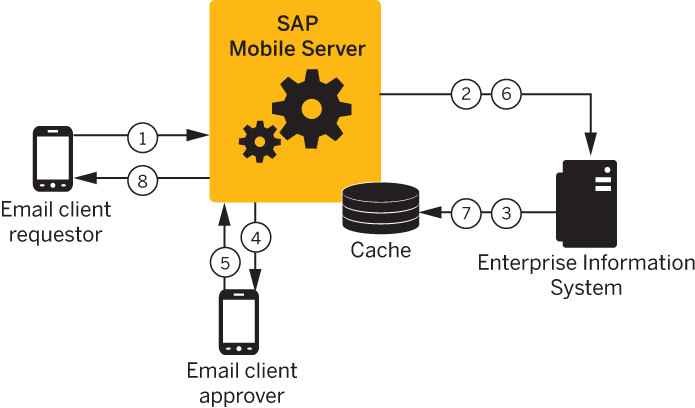In the HTML5/JS Hybrid App model, when you invoke an MBO operation located on Unwired Server using a Submit action, you can specify synchronous behavior (the messaging application waits for a successful or failed response from Unwired Server before proceeding). From an MBO/EIS perspective, Unwired Server updates are asynchronous (the server does not wait for a response).
Some of the differences between Hybrid Apps and replicated mobile applications include:
- The MBOs included in the application are no different than any other MBO: same types of parameters, attributes, CDB caching, synchronization methods, and so on.
- There is no permanent storage of the message portion of the Hybrid App. For example, a Hybrid App consists of the MBO portion, which is managed by Unwired Server, and the message portion. The message portion is the transient store and forward system to deliver the messages reliably between server and device client, and takes advantage of the capability to build messages on the fly and send to the interested devices without them having to explicitly know or request it.
This Hybrid App example is a travel approval e-mail
based application that includes:
- A TravelRequest MBO that includes:
- dates, location, estimated costs, purpose, and a unique ID.
- status and comment – included in the MBO definition but implemented by the business process widget.
- An object query that returns a row based on the submitted ID.
- Two triggers:
- Sends a message to the approver when a new row is inserted into the MBO table.
- Notifies the requester when the status of the request has been updated by the approver.
- A business process widget that implements the status and comment portion of the application.

- An e-mail requesting travel is submitted.
- Depending on the data refresh schedule or the operation's cache policy, the Server contacts the EIS.
- The cache is updated.
- Triggers a message to the approver.
- The travel request is approved through e-mail.
- The EIS is updated with the approved information.
- Depending on the data refresh schedule or the operation's cache policy, the cache is updated.
- The requester receives approval.